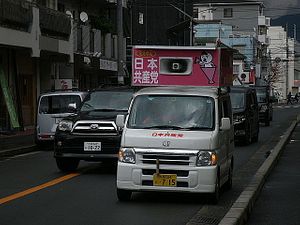Sunday’s snap election proved a victory for Shinzo Abe and his Liberal Democratic Party (LDP). His ruling coalition, composed of the LDP and Komeito, returned to govern Japan with a two-thirds majority in the Lower House of Parliament and a renewed sense of support for its policy priorities. But with voter turnout at a postwar low, and one-fourth of the seats still in opposition hands, Abe must persuade many Japanese that he can do what he has promised to revive their economy.
Last Friday, I suggested three areas to watch in terms of evaluating Abe’s snap election. The first was voter turnout. As expected, fewer Japanese voted in this election than in the past; 52 percent turned out for this election compared with 59 percent last time. In short 7 percent fewer Japanese voted to give the ruling coalition more seats, suggesting a slimmer mandate than the election that brought Abe to power in 2012. But this election was not about a change in government, and thus, even though the numbers were lower, few expected voter turnout to equal elections in the past.
Second, the results proved mixed for Japan’s opposition parties. Overall, they fared poorly, and the tactical advantage of holding an early election worked in the prime minister’s favor. The Democratic Party of Japan (DPJ), the largest of Japan’s opposition parties, gained eleven seats, but lost some of its leaders. In fact, the president of the party, Banri Kaieda, lost his seat in Tokyo, and has resigned as leader of the party. Similarly, other incumbents, such as former prime minister Naoto Kan, also lost in their single member districts, but were returned to the Diet through the party’s proportional lists. The Japan Innovation Party (Ishin no Kai) did better than expected, but only came in with forty one seats. The star of the opposition field was the Japan Communist Party (JCP), which gained in stature as Japan’s new veto party. Going from eight to twenty-one seats, the JCP has increased its position in the Lower House, as it now can sponsor legislation. Both the left and the right ends of the political spectrum lost; the Japan Socialists and the Next Generation parties came in with only two seats each.
Finally, what issues did the Japanese voter say mattered to them? Interestingly, while the LDP claims this was a referendum on Abenomics, there was a decidedly skeptical view of the Abe Cabinet’s progress to date. In an NHK exit poll, only 54 percent of those surveyed gave Abenomics a favorable rating (9 percent evaluated it highly and 45 percent evaluated it somewhat) compared with 46 percent of those who did not (33 percent not much and 13 percent not at all).
There was little evidence that this election produced a mandate on other policy issue areas. In terms of security and foreign policies, several aspects of the outcome were interesting. First, for those who see a turn to the right in Japan, it was notable that several outspoken nationalist advocates, Shintaro Ishihara and Toshio Tamogami, were defeated. This does not mean that nationalist sentiment has been defeated, but rather that the most conspicuous advocates cannot be elected on that sentiment alone. Second, despite all of the popular anxiety about tensions between Japan and its neighbors, there was little evidence that this translated into a campaign for a more confrontational foreign policy. Finally, the outcome of this election will have significant impact on the longstanding base relocation plan in Okinawa. Following on the November election of Takeshi Onaga – who has long opposed the government relocation plan – as Okinawa’s new governor, the LDP’s loss of all four Lower House seats in Okinawa is a game-changer for base politics there.
Some other highlights of this election spoke volumes about Japanese politics. First, Japan’s political families remain in play. Some offer a much-needed glimpse of Japan’s future leadership. Shinjiro Koizumi, son of former Prime Minister Junichiro Koizumi, was the campaigner of choice for many of the LDP’s older politicians. Drawing huge crowds and much younger voters, Shinjiro is one of the LDP’s best electoral weapons, and perhaps the time has come to elevate him to a much higher role in the party. Yuko Obuchi, daughter of former Prime Minister Keizo Obuchi, resigned from Abe’s last cabinet over campaign financing issues, but she tearfully accepted her constituents support for her return to the Lower House.
Second, the composition of Japan’s parliament is slowly changing. There were more women in this campaign than in earlier campaigns, demonstrating the rising support for female political leaders in Japan. Of the 198 female candidates in Sunday’s election, forty-five were voted into office, representing an increase of seven since 2012. Nonetheless, this represents less than 10 percent of Japan’s lower house. Demographics still matter, however. More data will be needed before we can fully assess the role of younger Japanese in this election, but if who showed up at the campaign rallies is any indicator, this was still an election for the upper end of Japan’s demographic.
Finally, the LDP and Komeito spent considerable time trying to persuade rural voters that their time would come. The LDP campaign focused largely on persuading Japan’s countryside that it was the next focal point in their government’s economic revitalization plan.
Yesterday, those who voted in Japan voted for stability, and for their government’s continued effort at setting their economy back on a positive track. With his ruling coalition intact, the prime minster will need to get to work now on seriously tackling the difficult choices ahead. He has announced that he will keep his Cabinet, as well as the party leadership.
Japan’s opposition parties have also been given a clear message. They must become more forceful advocates of their ideas for Japan’s future if they are to survive.
Sheila A. Smith is Senior Fellow for Japan Studies at the Council on Foreign Relations. This post appears courtesy of CFR.org and Forbes Asia.
































